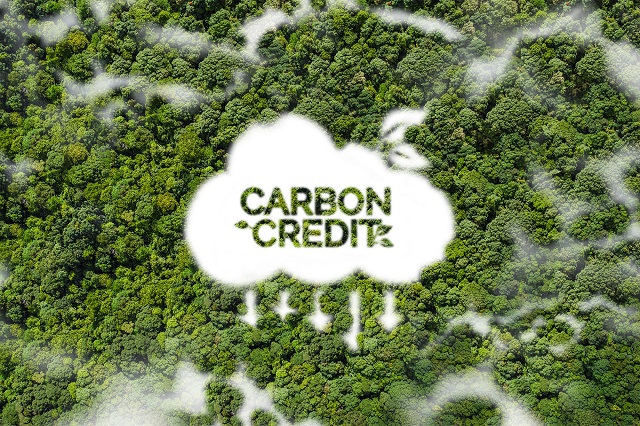Carbon credits have emerged as a pivotal tool in the global effort to curb greenhouse gas emissions, employing market mechanisms to incentivize emission reductions. Each carbon credit represents the right to emit one ton of CO₂ or its equivalent in other greenhouse gases. Essentially, it serves as a tradable permit, bought and sold on carbon markets, with the ultimate goal of reducing global emissions through cap-and-trade mechanisms.
Currently, carbon markets operate under two primary models: compliance markets and voluntary markets. In compliance markets, regulatory bodies allocate emission allowances to businesses; if a company exceeds its limit, it must purchase additional credits from lower-emitting entities or certified emission reduction projects. Conversely, if a company emits less than its allowance, it can sell the surplus.
Voluntary markets, on the other hand, allow businesses, organizations, and individuals to proactively purchase carbon credits to offset unavoidable emissions, serving voluntary sustainability goals or enhancing their environmental image.
According to McKinsey, the carbon credit market is projected to surpass $50 billion by 2030, with demand expected to increase fifteenfold compared to current levels, driven by Net Zero commitments and investor and consumer pressures. Carbon credits not only optimize costs but also confer significant brand advantages. Businesses that proactively purchase credits, especially those certified by reputable organizations like Verra (VCS), are often perceived as more committed to sustainability and adept at environmental risk management.
In the first quarter of 2025, Sylvera reported that 54.56 million credits had been “retired,” indicating their utilization to offset emissions. Global corporations like Shell and Microsoft continue to leverage carbon credits as a strategic pivot in their transition journeys, simultaneously offsetting emissions and solidifying their positions within the greening global supply chain.
Drivers Behind the Carbon Credit Trend
Direct Emission Reduction is Costly and Time-Consuming
One of the primary reasons many businesses opt for carbon credits instead of immediate investments in internal emission reduction solutions is the cost factor and implementation timeline. According to RepuTex Energy, certain industries face emission reduction costs exceeding $100 per ton of CO₂, particularly in challenging sectors like chemicals, steel, aviation, and cement. Additionally, implementing technology-driven projects or overhauling production processes can take years to yield significant results.
RepuTex’s predictive model indicates that the period from FY31 to FY33 could deliver higher emission reductions than the cumulative efforts from FY24 to FY30, thanks to large-scale infrastructure investments coming online.
In this context, carbon credits offer a “bridge” solution, enabling businesses to meet mid-term emission reduction targets without disrupting operations.
Recognizing the cost burden on businesses, Vietnam’s Ministry of Natural Resources and Environment proposed amending Decree 06/2022/NĐ-CP on greenhouse gas emission reduction. The amendment suggests increasing the allowable proportion of carbon credits for offsetting emissions from 10% to 30% in the initial phase. This proposal aims to alleviate pressure on businesses during the transition and leverage credits generated from afforestation projects or other emission reduction initiatives to meet national targets.
Carbon Credits Offer Flexibility and Rapid Implementability
Carbon credits provide a flexible tool for businesses to offset unavoidable emissions while maintaining compliance with climate commitments. This mechanism enables companies not yet ready for an immediate transition to still contribute to global emission reduction efforts.
The Carbon Knowledge Hub highlights 2025 as a pivotal year for enhancing the interconnectivity of global carbon markets. Simultaneously, the Science Based Targets initiative (SBTi) is finalizing guidelines to formally allow businesses to incorporate carbon credits into their Net Zero trajectories. BloombergNEF forecasts that SBTi may raise the threshold for credit usage beyond 10% of residual emissions, paving the way for a market scale of nearly 6 billion tons of CO₂ equivalent by 2050.
Investor, Consumer, and Regulatory Pressures Mount
Beyond financial considerations, businesses are turning to carbon credits to meet the expectations of key stakeholders, notably international investors and consumers. Demonstrating concrete action through credit purchases can be a pivotal component of sustainability reporting and non-financial disclosures.
In Vietnam, Decision 232/QĐ-TTg, issued on January 24, 2025, sets the goal of finalizing the legal framework for carbon credit trading, emission allowances, and offset mechanisms by June 2025. This regulation aims to pilot a domestic carbon trading platform, empowering businesses to operate more effectively amidst the evolving regional and global carbon market landscape.
Carbon Credits Bolster Corporate Image and Communication Strategies
The utilization of carbon credits also bestows a potent marketing advantage on businesses. Through credit purchases, companies can cultivate a “green” image in the eyes of consumers and stakeholders. However, environmental organizations have criticized this as a potential form of “greenwashing.”
Carbon Market Watch asserts that this phenomenon undermines the climate change mitigation efforts outlined in the Paris Agreement by offering a “double-edged loophole” to major polluters. On the one hand, emission offsetting allows companies to eschew costly internal decarbonization efforts. On the other hand, it provides them with a potent marketing tool to greenwash their image while weakening the case for more robust regulatory action.
This dynamic is exemplified by Shell, the largest purchaser of carbon credits in 2024, with 14.1 million credits—nearly triple the amount from previous years. Notably, over half of these credits were used in December alone, suggesting that credit purchases may be a strategic component of the company’s year-end communications and reporting.

Controversies and Challenges in the Carbon Credit Landscape
Despite their role in facilitating the green transition, carbon credit markets face controversies, particularly regarding integrity and actual effectiveness. One of the primary concerns is whether each credit genuinely represents a credible emission reduction or is merely a symbolic gesture.
MSCI’s 2024 report on sustainability and climate trends revealed significant improvements in the quality of credits within the voluntary carbon market, but there is still room for enhancement. Based on MSCI’s carbon credit rating system as of mid-2024, nearly 50% of retired credits held a B rating or lower, while only 8% attained an A or AA rating. No projects achieved the highest AAA rating. Nonetheless, from Q2 2022 to Q2 2024, the proportion of credits with the lowest CCC rating decreased from 29% to 15%, and the share of A or AA-rated credits doubled, indicating a marked improvement in quality and transparency.
However, the global carbon market continues to grapple with challenges like inconsistent verification mechanisms, concerns over additionality, double-counting risks, and fragmented evaluation standards. Addressing these barriers is essential to ensure the market’s effective contribution to climate efforts and safeguard economic value for businesses.
In Vietnam, according to the PanNature Center, there were 276 registered projects under the Clean Development Mechanism (CDM) as of November 2022, resulting in the issuance of approximately 30 million carbon credits. However, to effectively participate in the global and regional carbon markets, Vietnam needs to refine the criteria for ensuring quality, oversight, and transparency for domestic carbon credit-generating projects.
The Long-Term Viability of Carbon Credits
A pivotal question surrounds the long-term role of carbon credits in combating climate change. International experts and policymakers are engaged in ongoing discussions about the limits and true potential of this instrument. Projections indicate that a well-designed and transparent global carbon credit market could facilitate the elimination or avoidance of up to 5.9 gigatons of CO₂ emissions by 2050.
However, to realize this potential, the market requires comprehensive reforms, especially regarding credit integrity, measurement methodologies, and verification systems.
A critical factor influencing the future of carbon credits will be the updated guidance from the Science Based Targets initiative (SBTi). Currently, SBTi mandates that businesses reduce emissions by at least 90% across their entire value chain. In 2025, the organization will decide whether to permit the use of credits to offset Scope 3 emissions. This decision will shape the framework for corporate climate strategies and define the role of carbon credits in Net Zero commitments.
In Vietnam, policy directions signal conditional support for carbon credits as an economic tool for emission management. Deputy Prime Minister Tran Hong Ha emphasized that carbon credit markets not only contribute to Net Zero targets but also foster emission reduction through market mechanisms, where more efficient reducers can trade allowances.
The Carbon Development Proposal underscores the role of carbon credits in supporting NDC implementation, promoting green transformation, fostering low-emission technologies, and enhancing the competitiveness of Vietnamese businesses. Additionally, it is envisioned as a supplementary financial source for domestic emission reduction efforts, bolstering the nation’s journey toward Net Zero by 2050.
[1] https://offsetguide.org/understanding-carbon-offsets/what-is-a-carbon-offset/
[2] https://www.investopedia.com/terms/c/carbon_credit.asp
[3] https://www.mckinsey.com/capabilities/sustainability/our-insights/a-blueprint-for-scaling-voluntary-carbon-markets-to-meet-the-climate-challenge
[4] https://verra.org/programs/verified-carbon-standard/
[5] https://www.mckinsey.com/capabilities/sustainability/our-insights/a-blueprint-for-scaling-voluntary-carbon-markets-to-meet-the-climate-challenge
[6] https://www.sylvera.com/blog/carbon-data-q1-2025
[7] https://carbonmarketinstitute.org/app/uploads/2025/04/Carbon-Market-Report-2025-FINAL.pdf
[8] https://carbonmarketinstitute.org/app/uploads/2025/04/Carbon-Market-Report-2025-FINAL.pdf
[9] https://vnexpress.net/de-xuat-doanh-nghiep-duoc-mua-30-tin-chi-bu-tru-phat-thai-4872780.html
[10] https://www.carbonknowledgehub.com/factsheets/things-to-watch-in-global-carbon-markets-in-2025
[11] https://carbonmarketwatch.org/2025/02/12/behind-the-green-curtain-big-oil-and-the-voluntary-carbon-market/
[12] https://carbonmarketwatch.org/2025/02/12/behind-the-green-curtain-big-oil-and-the-voluntary-carbon-market/
[13] https://carboncredits.com/carbon-markets-in-2025-a-new-era-of-accountability-quality-and-transparency/
[14] https://vjst.vn/Images/Tapchi/2024/4A/28-4A-2024.pdf?utm
[15] https://www.southpole.com/publications/2025-carbon-market-buyers-guide
[16] https://carboncredits.com/carbon-markets-in-2025-a-new-era-of-accountability-quality-and-transparency/
[17] https://moit.gov.vn/bao-ve-moi-truong/thi-truong-tin-chi-carbon-can-di-truoc-de-bao-dam-loi-ich-quoc-gia-doanh-nghiep.html
– 08:00 11/05/2025
“Securities and Carbon Credits: Exploring Their Viability as Collateral”
Experts unanimously agree that there is an urgent need to develop a comprehensive legal framework that recognizes and regulates digital assets and carbon credits in banking practices.
The End of the Road for Gas Guzzlers: A Line-Up of Fuel-Powered Cars Faces the Axe
The automotive industry is facing a significant shift with the implementation of upcoming fuel consumption limits. Manufacturers and dealers must adapt to these changing standards or risk having their vehicle models taken off the market. This development will undoubtedly impact a wide range of car and motorcycle designs, urging a necessary evolution in the industry.
The Fresh Vietnamese Milk Producer’s Pledge: Carbon Neutrality and Net Zero
At a recent Carbon Neutrality Certification Ceremony, representatives from the TH Group (owners of the national brand TH true MILK) announced their commitment to maintaining carbon neutrality at two of their member units – TH Milk Joint Stock Company and Nui Tien Pure Water Limited Company. The companies will uphold this status according to the PAS 2060: 2014 standard until 2028, after which they aim to achieve neutrality in accordance with ISO 14068.
Carbon Trading Platform: Vietnam to Launch Pilot in June 2025
The Vietnamese government has unveiled an ambitious plan for a national carbon market. According to the proposal, a pilot carbon trading platform will be launched in June 2025, with official operations commencing in 2029. This marks a significant step forward in Vietnam’s commitment to tackling climate change and transitioning to a low-carbon economy.
Carbon Credit Sales: Empowering Farmers to Prosper
Ecological agriculture and circular farming are not just methods of cultivation, but a philosophy that strives for long-term sustainability for both people and the planet. With a shared goal of achieving Net Zero by 2050, Vietnam’s agricultural sector is undergoing a transformation towards ecological farming practices to protect natural resources and community health, paving the way for a green, clean, and resilient future.





















